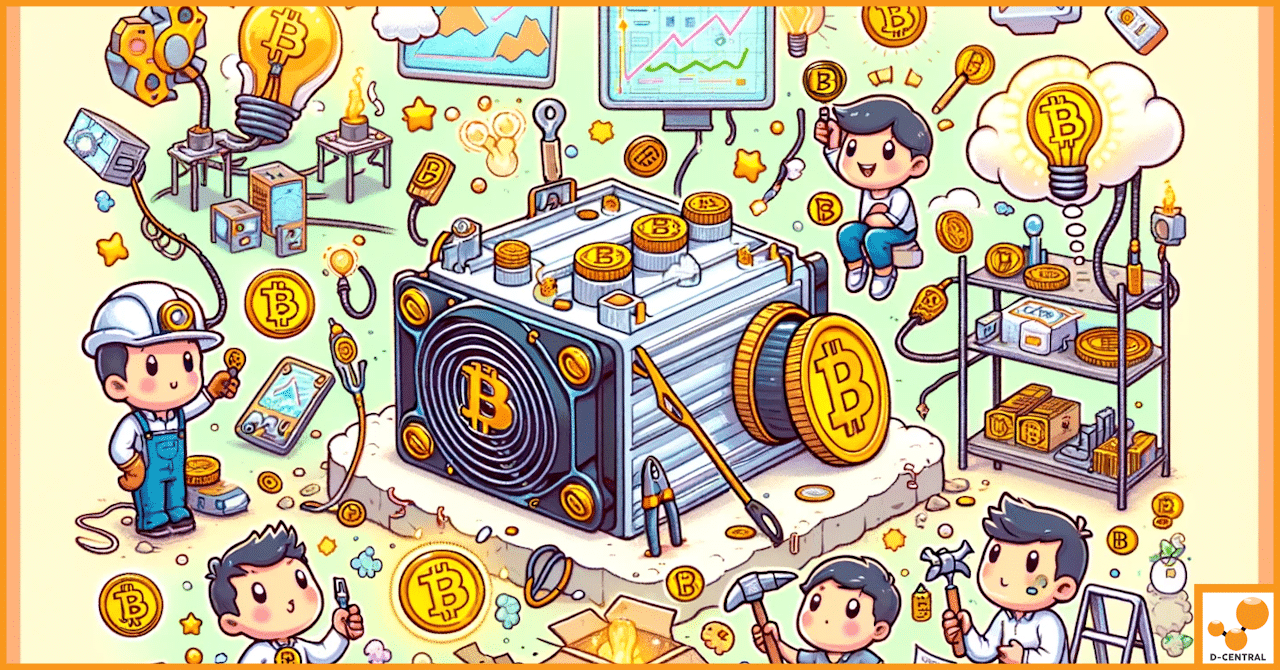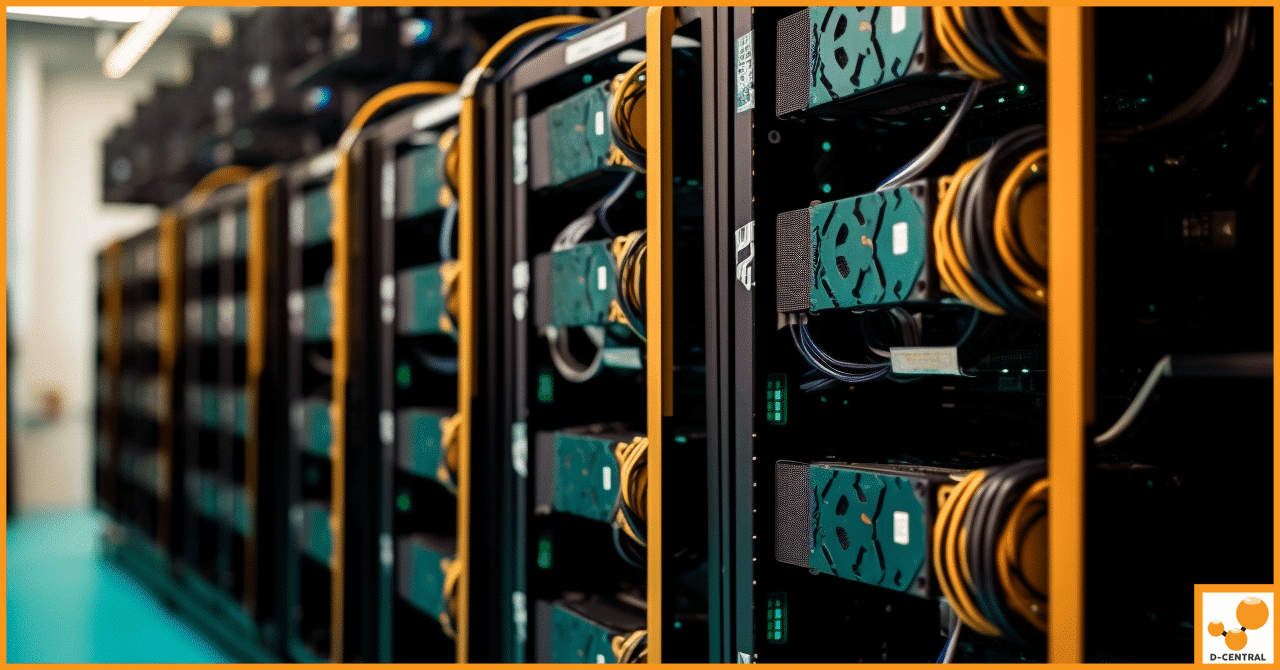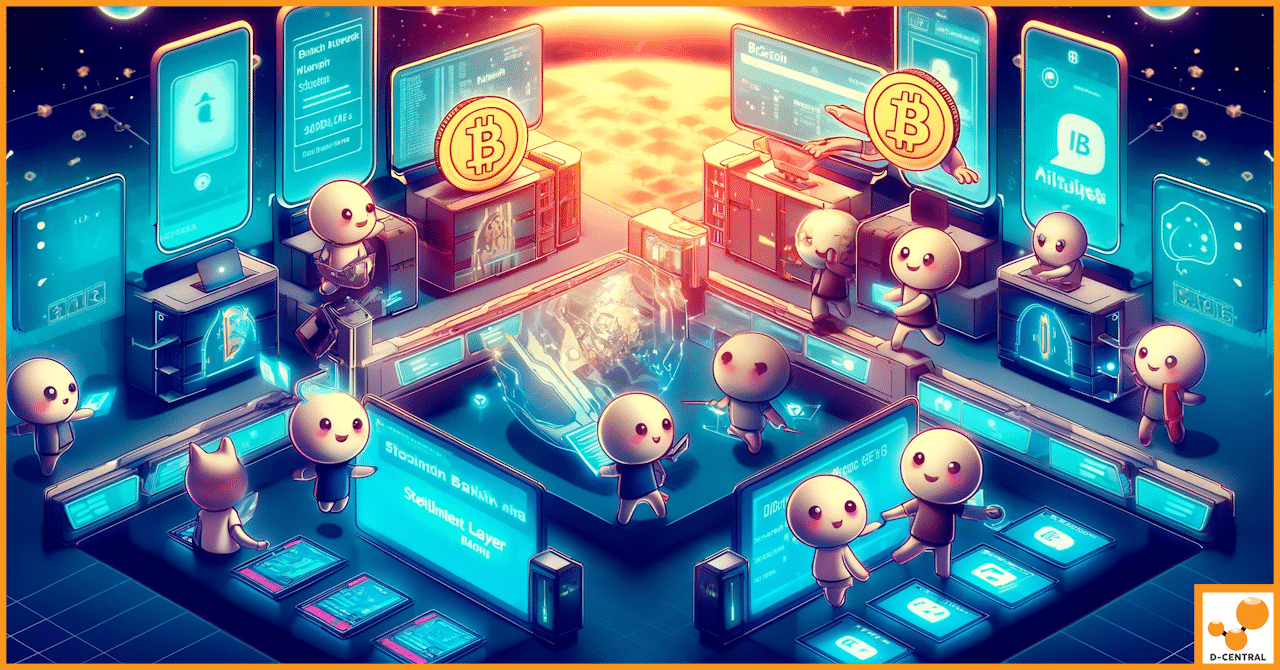
Used ASIC Miners: How to Repurpose – The Ultimate Guide
In the dynamic world of cryptocurrency mining, Application-Specific Integrated Circuit (ASIC) miners have emerged as the gold standard for efficiency
4479 Desserte Nord Autoroute 440, Laval, QC H7P 6E2

Bitcoin mining stands as a fundamental pillar that supports the entire Bitcoin ecosystem. Governed by the principles of proof of work, mining is not just a technical process but a symbol of the innovation and decentralization that makes Bitcoin a groundbreaking financial technology.
Bitcoin mining is the process by which new bitcoins are introduced into circulation and transactions are added to the public ledger known as the blockchain. Miners use powerful computers to solve many mathematical problems, and the first one to solve the main problem gets to add the next block to the blockchain, receiving newly minted bitcoins as a reward. In pool mining, all the miners combine their resources to increase the chances of earning rewards, sharing both computational power and the resulting payouts.
Proof of work (PoW) is the consensus algorithm that underpins Bitcoin mining. It requires miners to expend computational energy to solve mathematical puzzles, making it costly and time-consuming to produce new blocks. This proof of work process ensures that blocks are created in a decentralized manner, preventing any single entity from controlling the network.
Mining is not just about creating new bitcoins; it’s about maintaining the integrity and security of the entire Bitcoin network. Through mining, the decentralized nature of the Bitcoin blockchain is preserved, and the network is protected against potential attacks.
Cryptocurrency mining is the backbone of digital currencies like Bitcoin, ensuring the security, integrity, and decentralization of blockchain networks. At its core, mining is the process of validating and adding new transactions to the blockchain—a public, tamper-resistant ledger. This process is fundamental to proof-of-work (PoW) cryptocurrencies, where miners compete to solve complex mathematical puzzles using powerful computers.
The first miner to solve the puzzle earns the right to add a new block to the blockchain, receiving a reward that consists of newly minted coins (known as the block subsidy) and transaction fees paid by users. These incentives drive the mining industry, encouraging miners to continually seek out the most efficient and profitable methods. As the landscape evolves, miners must choose between solo mining, where they operate independently, and pool mining, where they collaborate with others to increase their chances of earning rewards.
Whether you’re interested in solo mining and pool mining for the potential of earning block rewards or simply want to understand how cryptocurrency mining supports the entire ecosystem, it’s clear that mining is a dynamic and competitive field. The pursuit of transaction fees and block subsidies keeps miners innovating, making mining a cornerstone of the cryptocurrency world.
Solo mining represents the roots of Bitcoin mining, where individual miners take on the entire network’s computational challenge.
Solo mining, as the name suggests, involves individual miners who mine bitcoins independently. Unlike pool mining, where miners combine their computational power, solo miners face the entire network’s difficulty on their own. The rewards are significant if a block is found, but the challenges and risks are equally high. Solo miners may go extended periods without earning any rewards due to the competitive nature of mining. Solo mining requires significant investment in hardware, infrastructure, and electricity, making it a demanding pursuit.
The global hash rate is a measurement of the total computing power used to secure the Bitcoin network. It’s a critical metric that reflects the network’s health and security. The network’s total hash rate directly affects the probability of successfully mining blocks, as a higher hash rate means increased competition and lower odds for individual miners.
Mining equipment has evolved dramatically since the early days of Bitcoin. From basic CPUs to specialized , the technology has become more sophisticated and efficient. The average machine now in use is about 90TH/sec, meaning that roughly 4.1 million mining ASIC systems are currently powering the network.
Solo mining represents a fascinating aspect of the Bitcoin ecosystem, reflecting the decentralized ethos of cryptocurrency. Solo miners are responsible for mining blocks independently, which is a challenging process due to the high network hash rate. With the evolution of mining technology and the rise of global hash rates, solo mining has become a pursuit for the highly dedicated and well-resourced miner.
Understanding the dynamics of solo mining, the global hash rate, and the role of mining equipment like Bitmain and MicroBT provides valuable insights into the complex world of Bitcoin mining. It’s a world driven by technological innovation, economic incentives, and the relentless pursuit of decentralization.
Whether you’re an aspiring solo miner or simply intrigued by the mechanics of Bitcoin, the world of solo mining offers a glimpse into the heart and soul of the cryptocurrency revolution.
The success and profitability of any mining operation—whether solo or pool mining—depend heavily on the quality and efficiency of the mining hardware and supporting infrastructure. The two primary types of mining equipment are Application-Specific Integrated Circuits (ASICs) and Graphics Processing Units (GPUs).
ASICs are custom-built microchips designed for a single purpose: running the cryptographic algorithms required for crypto mining, such as Bitcoin’s SHA-256. These machines deliver maximum speed and energy efficiency, making them the standard for large-scale mining operations. However, ASICs are limited to specific algorithms and cannot be repurposed for other tasks.
GPUs, on the other hand, are versatile processors capable of handling a variety of mining algorithms. While they may not match ASICs in raw power or energy efficiency, GPUs are popular among hobbyists and small-scale miners due to their lower upfront costs and flexibility—they can be used for gaming, AI, or other computing tasks when not mining.
Beyond the hardware itself, successful mining operations require robust infrastructure: reliable power supplies, effective cooling systems, stable network connectivity, and regular maintenance. These factors are crucial for maximizing energy efficiency and minimizing downtime, regardless of whether you’re mining independently or as part of a pool.
Understanding the strengths and limitations of different mining equipment, as well as the importance of supporting infrastructure, is essential for anyone looking to optimize their approach to solo and pool mining. The right combination of hardware and operational setup can make all the difference in the competitive world of crypto mining.
The economics of Bitcoin mining is a complex and multifaceted subject, encompassing various elements that contribute to the financial viability of mining operations. From block rewards to difficulty adjustments, this section explores the intricate balance that governs the world of mining. The value of mined coins can fluctuate significantly due to market volatility, directly impacting the profitability of both solo and pool mining strategies.
Block rewards are the financial incentives that motivate miners to contribute their computational power to the Bitcoin network. They consist of several components:
Bitcoin’s difficulty adjustment is a mechanism that ensures the consistent timing of block creation, regardless of changes in the global hash rate.
The block processing time is the average time taken to mine a block. While the goal is ten minutes, there is a variance in the actual time.
The economics of mining is deeply connected to the Bitcoin price, the financial rewards for miners, and the frequency of mining:
The economics of Bitcoin mining is a sophisticated interplay of incentives, adjustments, and market forces. Understanding these dynamics is essential for anyone involved in mining or interested in the financial mechanisms that underpin the Bitcoin network.
From the allure of block rewards to the precision of difficulty adjustments, the economics of mining paints a vivid picture of innovation, competition, and the relentless pursuit of decentralization.
Whether you’re a seasoned miner, a Bitcoin maximalist, or a curious observer, the world of mining economics offers a rich and rewarding exploration of the principles that make Bitcoin a revolutionary digital currency.
Solo mining, while offering the potential for significant rewards, is fraught with challenges and risks. The odds of successfully mining a block as a solo miner are heavily influenced by the miner’s hash rate and the overall network difficulty.
Scaling up by adding more mining systems can improve the likelihood of winning a block, but it also increases the financial risk.
Electricity consumption is one of the most significant costs in Bitcoin mining, and it can make or break a solo mining operation.
Solo mining is a high-risk, high-reward venture that requires careful consideration of the odds, costs, and potential rewards. From understanding the mining odds to evaluating the costs of scaling up and electricity consumption, solo miners must navigate a complex landscape fraught with challenges.
The allure of solo mining is undeniable, but the risks are equally stark. It’s a pursuit for the highly dedicated, well-resourced, and risk-tolerant miner.
Understanding the challenges and risks of solo mining provides valuable insights for those considering this path. It’s a world of potential riches and potential ruin, driven by the relentless pursuit of decentralization and the cypherpunk ethos that underpins the Bitcoin revolution.
The world of Bitcoin mining has evolved significantly since its inception, and one of the most notable developments is the emergence of mining pools. These collaborative efforts have become a cornerstone of the mining landscape, offering individual miners the opportunity to combine their hash power and work together. This section explores the concept of mining pools, their importance, and the different payout methods, including Pay-Per-Last-N-Shares (PPLNS) and Pay Per Share (PPS).
Mining pools are groups of miners who work together to mine blocks and then share the rewards. Each participant’s contributed hash power determines their share of the rewards in the pool. They play a crucial role in the mining ecosystem by:
Larger pools often offer frequent payouts and greater stability, but they may control significant portions of the network’s hash rate, raising concerns about centralization and network security. Pool miners benefit from more consistent income streams and lower barriers to entry compared to solo mining, making it accessible for newcomers and hobbyists. The pool operator is responsible for managing the pool, distributing rewards, maintaining network connectivity, and ensuring transparency and trust among participants. Mining pools can be compared to staking pools, as both involve pooling resources to increase the chances of earning rewards. Within a mining pool, rewards are distributed based on miner contributed shares, which serve as proof of work and determine each participant’s portion of the payout.
When it comes to mining, operational costs and service fees play a significant role in determining profitability. Most mining pools charge fees—typically between 1% and 3% of the block rewards—to cover operational costs such as server maintenance, software development, and customer support. These pool fees are deducted before rewards are distributed to pool members, ensuring the pool can continue to provide reliable mining services.
Solo mining offers a different financial structure. Unlike pool mining, solo miners keep the entire block reward, including both the block subsidy and transaction fees, since there are no pool fees involved. However, solo miners face higher operational costs, as they must provide all the necessary computational power and energy efficiency on their own. This can make solo mining a more resource-intensive and riskier endeavor, especially for those without access to low electricity costs or large-scale mining hardware.
Mining services, including pool management platforms and mining software, are essential for both solo and pool mining operations. These tools help miners monitor performance, optimize energy usage, and manage payouts. The choice between solo mining and pool mining ultimately depends on factors such as risk tolerance, available computational power, and the preference for consistent income versus the potential for a full block reward. Understanding the trade-offs between operational costs, pool fees, and potential earnings is key to making an informed decision in the mining industry.
PPLNS is a popular payout method used by mining pools. It offers a proportional distribution of rewards based on the work done by each pool member.
PPS pools offer a more consistent payout method, paying miners for their work regardless of whether the pool wins a block.
Mining pools have transformed the Bitcoin mining landscape, offering a collaborative approach that enhances profitability and reduces risk. The choice between PPLNS and PPS pools depends on individual preferences, risk tolerance, and the desire for consistency in payouts.
Understanding the dynamics of mining pools, including the advantages and risks of different payout methods, is essential for miners seeking to navigate the complex world of Bitcoin mining.
Whether you’re a seasoned miner or new to the world of cryptocurrency, mining pools offer an accessible and collaborative way to engage with the Bitcoin network. They embody the spirit of cooperation and innovation that drives the ongoing evolution of the Bitcoin ecosystem.
For many miners, pool mining offers the most practical path to consistent income and reduced risk. However, selecting the best mining pool requires careful consideration of several important factors. The size of the mining pool is a major consideration—large pools like Foundry USA, AntPool, and F2Pool provide stability, frequent payouts, and robust infrastructure, but they may charge higher fees and contribute to the centralization of the network. Smaller pools, while often offering lower fees and more personalized service, can result in higher variance in payouts and less predictable income.
Individual miners should also evaluate a pool’s reputation, transparency, and payout structure. Some pools use Pay Per Share (PPS) or Pay-Per-Last-N-Shares (PPLNS) models, each with its own balance of risk and reward. The best mining pool for you will depend on your hash power, risk tolerance, and whether you prioritize steady income or are willing to accept more variance for the chance at higher rewards.
Mining pools play a crucial role in the cryptocurrency mining ecosystem, enabling many miners to participate with less computational power and enjoy more predictable earnings. By carefully weighing factors such as pool size, fees, payout methods, and community reputation, miners can find the pool that best aligns with their goals and operational needs. In the ever-evolving world of crypto mining, choosing the right mining pool is a key step toward maximizing your mining success.
As the Bitcoin network continues to grow and evolve, the future of mining and the role of mining pools become increasingly significant. The mining landscape is shaped by technological advancements, economic factors, and the ever-present goal of decentralization. This section explores the future of mining, the role of pools in preventing centralization, and the trends shaping the industry.
Mining pools play a vital role in maintaining the decentralized nature of the Bitcoin network.
The future of mining is a dynamic and evolving landscape, shaped by technological innovation, economic factors, and the collective efforts of the mining community. Mining pools will continue to play a vital role in this future, fostering collaboration, enhancing profitability, and preserving the decentralized ethos of the Bitcoin network.
As we look to the future, the principles of cooperation, innovation, and decentralization remain at the heart of the mining industry. The role of pools in this future is not just a practical consideration but a reflection of the values that underpin the Bitcoin revolution.
Whether you’re an active miner or an observer of the cryptocurrency space, the future of mining offers exciting possibilities and challenges. It’s a journey of discovery, collaboration, and relentless pursuit of a decentralized and empowered future.
From understanding the basics of mining and the role of mining pools to exploring the technological advancements and the importance of decentralization, we’ve delved into the core of what makes Bitcoin mining a vital part of the cryptocurrency ecosystem.
At D-Central, we believe in the transformative power of Bitcoin and the principles of decentralization. We offer a comprehensive array of mining services tailored to meet the diverse needs of our clients.
Embracing the world of Bitcoin mining is not just about technology and profits; it’s about being part of a movement that champions freedom, innovation, and empowerment. At D-Central, we invite you to explore our services and become an active participant in this decentralized future.
Bitcoin mining is a complex yet rewarding endeavor, filled with opportunities, challenges, and the promise of a decentralized future. With D-Central by your side, you have a trusted partner to guide you through every step of your mining journey.
DISCLAIMER: D-Central Technologies and its associated content, including this blog, do not serve as financial advisors or official investment advisors. The insights and opinions shared here or by any guests featured in our content are provided purely for informational and educational purposes. Such communications should not be interpreted as financial, investment, legal, tax, or any form of specific advice. We are committed to advancing the knowledge and understanding of Bitcoin and its potential impact on society. However, we urge our community to proceed with caution and informed judgment in all related endeavors.
Related Posts

In the dynamic world of cryptocurrency mining, Application-Specific Integrated Circuit (ASIC) miners have emerged as the gold standard for efficiency

As the Bitcoin mining landscape becomes increasingly competitive, a miner’s success hinges not only on their ability to procure cutting-edge

In the intricate world of financial transactions, the settlement layer serves as the backbone of traditional banking systems, ensuring the